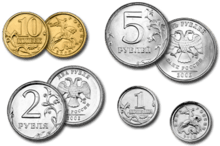Russian ruble
| Russian ruble | |||||
|---|---|---|---|---|---|
| Российский рубль (Russian)[note 1] | |||||
| |||||
| ISO 4217 | |||||
| Code | RUB | ||||
| Number | 643 | ||||
| Exponent | 2 | ||||
| Denominations | |||||
| Subunit | |||||
| 1⁄100 | kopeyka (копейка)[note 2] | ||||
| Plural | The language(s) of this currency belong(s) to the Slavic languages. There is more than one way to construct plural forms. | ||||
| Symbol | ₽, руб / р. (colloquially) | ||||
| kopeyka (копейка)[note 3] | коп. / к. | ||||
| Banknotes | |||||
| Freq. used | 50₽, 100₽, 200₽, 500₽, 1,000₽, 2,000₽, 5,000₽ | ||||
| Rarely used | 5₽, 10₽ | ||||
| Coins | |||||
| Freq. used | 1₽, 2₽, 5₽, 10₽ | ||||
| Rarely used | 1 коп., 5 коп., 10 коп., 50 коп. | ||||
| Demographics | |||||
| Official user(s) |
| ||||
| Unofficial user(s) |
Partially recognized
republics Unrecognized republics
| ||||
| Issuance | |||||
| Central bank | Bank of Russia | ||||
| Website |
www | ||||
| Printer | Goznak | ||||
| Website |
www | ||||
| Mint | Moscow Mint and Saint Petersburg Mint | ||||
| Valuation | |||||
| Inflation | 3.4%, September 2018 | ||||
| Source | Bank of Russia | ||||
| Method | CPI | ||||
The Russian ruble or rouble (Russian: рубль rublʹ, plural: рубли́ rubli; sign: ₽, руб; code: RUB) is the currency of the Russian Federation, the two partially recognized republics of Abkhazia and South Ossetia and the two unrecognized republics of Donetsk and Luhansk. The ruble is subdivided into 100 kopeks (sometimes written as kopecks or copecks; Russian: копе́йка kopeyka, plural: копе́йки kopeyki).
The ruble was the currency of the Russian Empire and of the Soviet Union (as the Soviet ruble). Today, apart from Russia, Belarus and Transnistria use currencies with the same name. The ruble was the world's first decimal currency: it was decimalised in 1704 when the ruble became equal to 100 kopeks.[1]
In 1992 the Soviet ruble (code: SUR) was replaced with the Russian ruble (code: RUR) at the rate 1 SUR = 1 RUR. In 1998 preceding the financial crisis, the Russian ruble was redenominated with the new code "RUB" and was exchanged at the rate of 1 RUB = 1,000 RUR.
History
The ruble is the oldest national currency after the Pound sterling, and the world's first decimal currency. The ruble has been used in the Russian territories since the 13th century.[2] The modern Russian ruble was created in December 1991 and used in parallel with the Soviet ruble, which remained in circulation until September 1993. All Soviet coins issued in 1961–1991, respectively, as well as 1-, 2- and 3-kopek coins, issued before 1961, formally remained legal tender until 31 December 1998, and in 1999–2001 they were exchanged for Russian ruble in the ratio of 1000:1.[3]
First ruble – RUR (1992–1998)
Following the breakup of the Soviet Union in 1991, the Soviet ruble remained the currency of the Russian Federation until 1992. A new set of coins was issued in 1992 and a new set of banknotes was issued in the name of Bank of Russia in 1993. The "Russian ruble" with the ISO 4217 code RUR and number 810 replaced the Soviet ruble at the rate 1 SUR = 1 RUR.
Coins
After the fall of the Soviet Union, the Russian Federation introduced new coins in 1992 in denominations of 1, 5, 10, 20, 50 and 100 rubles. The coins depict the double-headed eagle without a crown, sceptre and globus cruciger above the legend "Банк России" ("Bank of Russia"). It is exactly the same eagle that the artist Ivan Bilibin painted after the February Revolution as the coat of arms for the Russian Republic.[4] The 1- and 5-ruble coins were minted in brass-clad steel, the 10- and 20-ruble coins in cupro-nickel, and the 50- and 100-ruble coins were bimetallic (aluminium-bronze and cupro-nickel-zinc). In 1993, aluminium-bronze 50-ruble coins and cupro-nickel-zinc 100-ruble coins were issued, and the material of 10- and 20-ruble coins was changed to nickel-plated steel. In 1995 the material of 50-ruble coins was changed to brass-plated steel, but the coins were minted with the old date 1993. As high inflation persisted, the lowest denominations disappeared from circulation and the other denominations became rarely used.
During this period the commemorative one-ruble coin was regularly issued. It is practically identical in size and weight to a 5-Swiss franc coin (worth approx. €4.39 / US$5.09 as of August 2018). For this reason, there have been several instances of (now worthless) ruble coins being used on a large scale to defraud automated vending machines in Switzerland.[5]
Banknotes
In 1961, new State Treasury notes were introduced for 1, 3 and 5 rubles, along with new State Bank notes worth 10, 25, 50 and 100 rubles. In 1991, the State Bank took over production of 1-, 3- and 5-ruble notes and also introduced 200-, 500- and 1,000-ruble notes, although the 25-ruble note was no longer issued. In 1992, a final issue of notes was made bearing the name of the USSR before the Russian Federation introduced 5,000- and 10,000-ruble notes. These were followed by 50,000-ruble notes in 1993, 100,000 rubles in 1995 and, finally, 500,000 rubles in 1997 (dated 1995).
Since the breakup of the Soviet Union in 1991, Russian ruble banknotes and coins have been notable for their lack of portraits, which traditionally were included under both the Tsarist and Communist regimes. With the issue of the 500-ruble note depicting a statue of Peter I and then the 1,000-ruble note depicting a statue of Yaroslav, the lack of recognizable faces on the currency has been partially alleviated.
| Series | Value | Obverse | Reverse | Issuer | Languages |
|---|---|---|---|---|---|
| 1961 | 1, 3, 5, 10, 25, 50, 100 rubles | Vladimir Lenin or views of the Moscow Kremlin | Value, and views of the Moscow Kremlin for 50 rubles or higher | USSR | multiple |
| 1991 | 1, 3, 5, 10, 50, 100, 200, 500, 1,000 rubles | Russian | |||
| 1992 | 50, 200, 500, 1,000, 5,000, 10,000 rubles |
|
Russian | ||
| 1993 | 100, 200, 500, 1,000, 5,000, 10,000, 50,000 rubles | Moscow Kremlin with the tri-color Russian flag | Bank of Russia | ||
| 1995 | 1,000, 5,000, 10,000, 50,000, 100,000, 500,000 rubles | Same design as today's banknotes, where 1 new ruble = 1,000 old rubles. The 1,000 ruble note did not continue as a 1 new ruble note. | |||
Second ruble – RUB (1998–present)

In 1998, following the financial crisis, the Russian ruble was redenominated with the new ISO 4217 code "RUB" and number 643, and was exchanged at the rate of 1 RUB = 1,000 RUR. The redenomination was an administrative step that reduced the unwieldiness of the old ruble[6] but occurred on the brink of the 1998 Russian financial crisis.[7] The ruble lost 70% of its value against the US dollar in the six months following this financial crisis.
Ruble symbol

A currency symbol was used for the ruble between the 16th century and the 18th century. The symbol consisted of the Russian letters "Р" (rotated 90° counter-clockwise) and "У" (written on top of it). The symbol was placed over the amount number it belonged to.[8] This symbol, however, fell into disuse by the mid-19th century.[9]
No official symbol was used during the final years of the Empire, nor was one introduced in the Soviet Union. The characters R[10][11] and руб. were used and remain in use today, though they are not official.[12]
In July 2007, the Central Bank of Russia announced that it would decide on a symbol for the ruble and would test 13 symbols. This included the symbol РР (the initials of Российский Рубль "Russian ruble"), which received preliminary approval from the Central Bank.[13] However, one more symbol, a Р with a horizontal stroke below the top similar to the Philippine peso sign, was proposed unofficially.[13] Proponents of the new sign claimed that it is simple, recognizable and similar to other currency signs.[14][15][16] This symbol is also similar to the Armenian letter ք or the Latin letter Ꝑ.
On 11 December 2013, the official symbol for the ruble became ![]()
₽).[19][20]
On 4 February 2014, the Unicode Technical Committee during its 138th meeting in San Jose accepted U+20BD ₽ RUBLE SIGN symbol for Unicode version 7.0;[21] the symbol was then included into Unicode 7.0 released on 16 June 2014.[22] In August 2014, Microsoft issued updates for all of its mainstream versions of Microsoft Windows that enabled support for the new ruble sign.[23]
Coins
In 1998, the following coins were introduced in connection with the ruble revaluation:
| Image | Value | Technical parameters | Description | Years of minting | |||||
|---|---|---|---|---|---|---|---|---|---|
| Reverse | Obverse | Diameter | Mass | Composition | Edge | Obverse | Reverse | ||
| 1 коп. | 15.5 mm | 1.5 g[25] | Cupronickel-steel | Plain | Saint George | Value |
| ||
 |
 |
5 коп. | 18.5 mm | 2.6 g[26] |
| ||||
 |
 |
10 коп. | 17.5 mm | 1.95 g[27] | Brass | Reeded | Saint George | Value | 1997–2006 |
 |
 |
1.85 g | Brass-plated steel | Plain | 2006–2014 | ||||
 |
 |
50 коп. | 19.5 mm | 2.90 g[28] | Brass | Reeded | 1997–1999 2002–2006 | ||
 |
 |
2.75 g | Brass-plated steel | Plain | 2006–2014 | ||||
 |
 |
1₽ | 20.5 mm | 3.25 g | Cupronickel | Reeded | Emblem of the Bank of Russia | Value |
|
 |
 |
3.00 g | Nickel-plated steel | 2009–2015 | |||||
 |
 |
Coat of arms of Russia | 2016 | ||||||
 |
 |
2₽ | 23 mm | 5.10 g | Cupronickel | Segmented (Plain and Reeded edges) | Emblem of the Bank of Russia |
| |
 |
 |
5.00 g | Nickel-plated steel | 2009–2015 | |||||
 |
 |
Coat of arms of Russia | 2016 | ||||||
 |
 |
5₽ | 25 mm | 6.45 g | Cupronickel-clad copper | Emblem of the Bank of Russia |
| ||
 |
 |
6.00 g | Nickel-plated steel | 2009–2015 | |||||
 |
 |
Coat of arms of Russia | 2016 | ||||||
 |
 |
10₽ | 22 mm | 5.63 g | Brass-plated steel | Segmented (plain and reeded edges) | Emblem of the Bank of Russia | Value | 2009–2015 |
 |
 |
Coat of arms of Russia | 2016 | ||||||
One- and 5-kopek coins are rarely used (especially the 1-kopek coin) due to their low value and in some cases may not be accepted by stores or individuals. In some cases, the 10-kopek coin is disregarded (refused by individuals but is accepted by vendors and is mandatory for offer in exchange).
These coins began being issued in 1998, although some of them bear the year 1997. Kopek denominations all depict St George and the Dragon, and all ruble denominations (with the exception of commemorative pieces) depict the double headed eagle. Mint marks are denoted by "Л" or "M" on kopeks and the logo of either the Leningrad or Moscow mint on rubles. Since 2000, many bimetallic 10-ruble circulating commemorative coins have been issued. These coins have a unique holographic security feature inside the "0" of the denomination 10.
In 2008, it was proposed by the Bank of Russia to withdraw 1- and 5-kopek coins from circulation and subsequently round all prices to multiples of 10 kopeks, although the proposal has not been realized yet (though characteristic "x.99" prices are treated as rounded in exchange).
The material of 1-, 2- and 5-ruble coins was switched from copper-nickel-zinc and copper-nickel clad to nickel-plated steel in the second quarter of 2009. Ten and 50 kopeks were also changed from aluminum-bronze to brass-steel clad.
In October 2009, a new 10-ruble coin made of brass-plated steel was issued, featuring optical security features.[29] The 10-ruble banknote would have been withdrawn in 2012, but a shortage of 10-ruble coins prompted the Central Bank to delay this and put new ones in circulation.[30] Bimetallic commemorative 10-ruble coins will continue to be issued.
A series of circulating Olympic commemorative 25-ruble coins started in 2011. The new coins are made of cupronickel. A number of commemorative smaller denominations of these coins exist in circulation as well, depicting national historic events and anniversaries.
The Bank of Russia issues other commemorative non-circulating coins ranging from 1 to 50,000 rubles.[31]
Banknotes
On 1 January 1998 a new series of banknotes dated 1997 was released in denominations of 5₽, 10₽, 50₽, 100₽ and 500₽. The 1,000₽ banknote was first issued on 1 January 2001 and the 5,000₽ banknote was first issued on 31 July 2006. Modifications to the series were made in 2001, 2004, and 2010.
In April 2016, the Central Bank of Russia announced that it will introduce two new banknotes—200₽ and 2,000₽—in 2017.[32] In September 2016, a vote was held to decide which symbols and cities will be displayed on the new notes.[33] In February 2017, the Central Bank of Russia announced the new symbols, the 200₽ banknote will feature the symbols of Sevastopol and the Monument to the Sunken Ships and the view of Chersonesus, and the 2,000₽ banknote will bear images of famous Far Eastern sites and the bridge to Russky Island and the Vostochny Cosmodrome in the Amur Oblast.[34]
In 2018 the Central Bank issued a 100-ruble "commemorative" banknote designed to recognize Russia's role as the host of the 2018 World Cup soccer tournament. The banknote is printed on a polymer substrate, and has several transparent portions as well as a hologram. Despite the note being intended for legal tender transactions, the Central Bank has simultaneously refused to allow its own Automated Teller Machines (ATMs) to recognize or accept it.[35]
| Image | Value | Dimensions | Description | Date of | ||||||
|---|---|---|---|---|---|---|---|---|---|---|
| Obverse | Reverse | Obverse | Reverse | Watermark | printing* | issue | withdrawal | lapse | ||
_front.jpg) |
_back.jpg) |
5₽ | 137 × 61 mm | The Millennium of Russia monument on background of Saint Sophia Cathedral in Veliky Novgorod | Fortress wall of the Novgorod Kremlin | "5", Saint Sophia Cathedral in Novgorod | 1997 | 1 January 1998 | Current, but not issued since 2001. Very rarely seen in circulation. | |
 |
 |
10₽ | 150 × 65 mm | Kommunalny Bridge across the Yenisei River in Krasnoyarsk and Paraskeva Pyatnitsa Chapel | Krasnoyarsk hydroelectric plant | "10", Paraskeva Pyatnitsa Chapel |
|
Current, but not issued since January 2010. Still in use, but rarely seen in circulation. | ||
 |
 |
50₽ | A Rostral Column sculpture on background of Petropavlosk Fortress in Saint Petersburg | Old Saint Petersburg Stock Exchange and Rostral Columns | "50", Peter and Paul Cathedral | Current | ||||
 |
 |
100₽ | Quadriga on the portico of the Bolshoi Theatre in Moscow | The Bolshoi Theatre | "100", The Bolshoi Theatre | |||||
 |
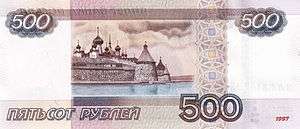 |
500₽ | Monument to Peter the Great, sailing ship and sea terminal in Arkhangelsk[37] | Solovetsky Monastery | "500", Monument to Peter the Great |
|
1 January 1998 | |||
 |
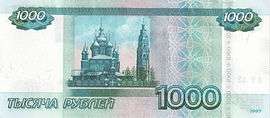 |
1,000₽ | 157 × 69 mm | Monument to Yaroslav I the Wise and the Lady of Kazan Chapel in Yaroslavl | John the Baptist Church in Yaroslavl | "1,000", Monument to Yaroslav I the Wise |
|
1 January 2001 | ||
 |
 |
5,000₽ | Monument to Nikolay Muravyov-Amursky in Khabarovsk | Khabarovsk Bridge over the Amur | "5,000", Head of the monument to Muravyov-Amursky |
|
31 July 2006 | |||
These images are to scale at 0.7 pixel per millimeter. For table standards, see the banknote specification table.
| ||||||||||
| Image | Value | Dimensions | Description | Date of | ||||||
|---|---|---|---|---|---|---|---|---|---|---|
| Obverse | Reverse | Obverse | Reverse | Watermark | printing | issue | withdrawal | lapse | ||
 |
 |
200₽ | 150 × 65 mm | View of Sevastopol and the Monument to the Sunken Ships (by sculptor Amandus Adamson) | View of Chersonesus | Monument to the Sunken Ships and electrotype "200" | 2017 | 12 October 2017 | Current | |
 |
 |
2,000₽ | 157 × 69 mm | Russky Bridge | Vostochny Cosmodrome | Russky Bridge and electrotype "2000" | 2017 | 12 October 2017 | ||
Printing
All Russian ruble banknotes are currently printed at the state-owned factory Goznak in Moscow, which was founded on 6 June 1919 and operated ever since. Coins are minted in Moscow and at the Saint Petersburg Mint, which has been operating since 1724.
100-ruble bill controversy
On 8 July 2014 State Duma deputy and Vice-Chairman of the Duma Regional Political Committee Roman Khudyakov alleged that the image of Apollo driving Quadriga on the portico of the Bolshoi Theatre in Moscow on the 100-ruble banknote constitutes pornography that should only be available to persons over the age of 18. Since it is impractical to limit the access of minors to banknotes, he requested in his letter to the Governor of the Bank of Russia Elvira Nabiullina to immediately change the design of the banknote.[39]
Khudyakov, a member of parliament for the LDPR party stated, "You can clearly see that Apollo is naked, you can see his genitalia. I submitted a parliamentary request and forwarded it directly to the head of the central bank asking for the banknote to be brought into line with the law protecting children and to remove this Apollo."[40][41] Khudyakov's efforts did not lead to any changes being made to the design.
Crimea controversy
On 13 October 2017, the National Bank of Ukraine issued a decree forbidding the country's banks, other financial institutions and Ukraine's state postal service to circulate Russian banknotes, which use images of Crimea, a territory that is regarded as Russian-occupied by Ukraine and the vast majority of UN member states.[42] The NBU stated that the ban applies to all financial operations, including cash transactions, currency exchange activities and interbank trade.[43] Crimea is featured on three banknotes that are currently in circulation – the 100 ruble commemorative notes issued in 2015 and 2018, as well as the 200 ruble note issued in 2017.
Commemorative banknotes
| Image | Value | Dimensions | Description | Date of | |||||||
|---|---|---|---|---|---|---|---|---|---|---|---|
| Obverse | Reverse | Obverse | Reverse | Watermark | printing* | issue | withdrawal | lapse | |||
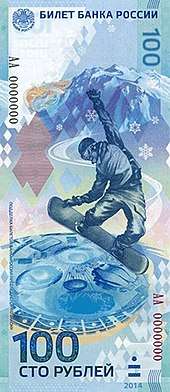 |
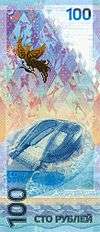 |
100₽ | 150 × 65 mm | A snowboarder and some of the Olympic venues of the Sochi coastal cluster. | Fisht Olympic Stadium in Sochi. | 2014 Winter Olympics logo | 2014 | 30 October 2013 | Current | ||
 |
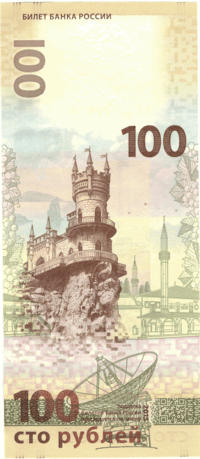 |
100₽ | 150 × 65 mm | Monument to Sunken Ships in Sevastopol bay and a fragment of a painting by Ivan Aivazovsky. | Swallow's Nest castle, Yevpatoria RT-70 radio telescope, and a green stripe containing a QR code linking to the Bank of Russia webpage containing historical information relating to the commemorative banknote. | Portrait of Empress Catherine the Great | 2015 | 23 December 2015 | |||
 |
 |
100₽ | 150 × 65 mm | A boy with a ball under his arm looking up as Lev Yashin saves a ball. | A stylized image of the globe in the form of a football with a green image of the Russia's territory (including Crimea) outlined on it, as well as the name of the 2018 FIFA World Cup host cities. | The number 2018 | 2018 | 22 May 2018 | |||
On 30 October 2013, a special banknote in honour of the 2014 Winter Olympics held in Sochi was issued. The banknote is printed on high-quality white cotton paper. A transparent polymer security stripe is embedded into the paper to make a transparent window incorporating an optically variable element in the form of a snowflake. The highlight watermark is visible in the upper part of the banknote. Ornamental designs run vertically along the banknote. The front of the note features a snowboarder and some of the Olympic venues of the Sochi coastal cluster. The back of the note features the Fisht Olympic Stadium in Sochi. The predominant colour of the note is blue.
On 23 December 2015, another commemorative 100-ruble banknote was issued to celebrate the "reunification of Crimea and Russia". The banknote is printed on light-yellow-coloured cotton paper. One side of the note is devoted to Sevastopol, the other one—to Crimea. А wide security thread is embedded into the paper. It comes out on the surface on the Sevastopol side of the banknote in the figure-shaped window. A multitone combined watermark is located on the unprinted area in the upper part of the banknote. Ornamental designs run vertically along the banknote. The Sevastopol side of the note features the Monument to Sunken Ships in Sevastopol bay and a fragment of the painting "Russian Squadron on the Roads of Sevastopol" by Ivan Aivazovsky. The Crimea side of the note features the Swallow's Nest, a decorative castle and local landmark. In the lower part of the Sevastopol side of the banknote in the green stripe there is a QR-code containing a link to the Bank of Russia's webpage, which lists historical information related to the banknote. The predominant colour of the note is olive green.
On 22 May 2018, a special banknote to celebrate the 2018 FIFA World Cup was issued.[45] The banknote is printed on polymer. The top part of the note bears a transparent window that contains a holographic element. The design of the note is vertically oriented. The main images of the obverse are a boy with a ball under his arm and a goalkeeper diving for a ball. The main image of the reverse is a stylized image of the globe in the form of a football with green image of the Russian territory outlined on it. On the reverse there is the number 2018 that marks both the issue of the banknote and the World Cup, as well as the name of the host cities in the Russian language. The bottom right corner of the obverse bears a QR-code, which contains a link to the page of the Bank of Russia website with the description of the note’s security features. Predominant colours of the note are blue and green.
Economics
| Rank | Currency | ISO 4217 code (symbol) | % daily share (April 2016) |
|---|---|---|---|
1 | USD (US$) | 87.6% | |
2 | EUR (€) | 31.4% | |
3 | JPY (¥) | 21.6% | |
4 | GBP (£) | 12.8% | |
5 | AUD (A$) | 6.9% | |
6 | CAD (C$) | 5.1% | |
7 | CHF (Fr) | 4.8% | |
8 | CNY (元) | 4.0% | |
9 | SEK (kr) | 2.2% | |
10 | NZD (NZ$) | 2.1% | |
11 | MXN ($) | 1.9% | |
12 | SGD (S$) | 1.8% | |
13 | HKD (HK$) | 1.7% | |
14 | NOK (kr) | 1.7% | |
15 | KRW (₩) | 1.7% | |
16 | TRY (₺) | 1.4% | |
17 | RUB (₽) | 1.1% | |
18 | INR (₹) | 1.1% | |
19 | BRL (R$) | 1.0% | |
20 | ZAR (R) | 1.0% | |
| Other | 7.1% | ||
| Total[note 5] | 200.0% | ||
The use of other currencies for transactions between Russian residents is punishable, with a few exceptions, with a fine of 75% to 100% of the value of the transaction.[47]
International trade
On 23 November 2010, at a meeting of Russian President Vladimir Putin and Chinese Premier Wen Jiabao, it was announced that Russia and China had decided to use their own national currencies for bilateral trade, instead of the US dollar. The move is aimed to further improve relations between Beijing and Moscow and to protect their domestic economies during the Great Recession. The trading of the Chinese yuan against the ruble has started in the Chinese interbank market, while the yuan's trading against the ruble was set to start on the Russian foreign exchange market in December 2010.[48][49]
In January 2014, President Putin said there should be a sound balance on the ruble exchange rate; that the Central Bank only regulated the national currency exchange rate when it went beyond the upper or lower limits of the floating exchange rate; and that the freer the Russian national currency is, the better it is, adding that this would make the economy react more effectively and timely to processes taking place in it.[50]
Exchange rates


The financial crisis in Russia in 2014–2016 was the result of the collapse of the Russian ruble beginning in the second half of 2014.[51][52][53][54][55][56] A decline in confidence in the Russian economy caused investors to sell off their Russian assets, which led to a decline in the value of the Russian ruble and sparked fears of a Russian financial crisis. The lack of confidence in the Russian economy stemmed from at least two major sources. The first is the fall in the price of oil in 2014. Crude oil, a major export of Russia, declined in price by nearly 50% between its yearly high in June 2014 and 16 December 2014. The second was the result of international economic sanctions imposed on Russia following Russia's annexation of Crimea and the Russian military intervention in Ukraine.[51][57]
The crisis affected the Russian economy, both consumers and companies, and regional financial markets, as well as Putin's ambitions regarding the Eurasian Economic Union. The Russian stock market in particular experienced large declines, with a 30% drop in the RTS Index from the beginning of December through 16 December 2014. From July 2014 to February 2015 the ruble fell dramatically against the U.S. dollar. A 6.5 percentage point interest rate rise to 17 percent[58] failed to prevent the currency hitting record lows in a "perfect storm" of low oil prices, looming recession and Western sanctions over the Ukraine crisis.[59]
| Year | Lowest ↓ | Highest ↑ | Average | |||||
|---|---|---|---|---|---|---|---|---|
| Date | Rate | Date | Rate | Rate | ||||
| 1998 | 1 January | 5.9600 | 29 December | 20.9900 | 9.7945 | |||
| 1999 | 1 January | 20.6500 | 29 December | 27.0000 | 24.6489 | |||
| 2000 | 6 January | 26.9000 | 23 February | 28.8700 | 28.1287 | |||
| 2001 | 4 January | 28.1600 | 18 December | 30.3000 | 29.1753 | |||
| 2002 | 1 January | 30.1372 | 7 December | 31.8600 | 31.3608 | |||
| 2003 | 20 December | 29.2450 | 9 January | 31.8846 | 30.6719 | |||
| 2004 | 30 December | 27.7487 | 1 January | 29.4545 | 28.8080 | |||
| 2005 | 18 March | 27.4611 | 6 December | 28.9978 | 27.1910 | |||
| 2006 | 6 December | 26.1840 | 12 January | 28.4834 | 27.1355 | |||
| 2007 | 24 November | 24.2649 | 13 January | 26.5770 | 25.5808 | |||
| 2008 | 16 July | 23.1255 | 31 December | 29.3804 | 24.8529 | |||
| 2009 | 13 November | 28.6701 | 19 February | 36.4267 | 31.7403 | |||
| 2010 | 16 April | 28.9310 | 8 June | 31.7798 | 30.3679 | |||
| 2011 | 6 May | 27.2625 | 5 October | 32.6799 | 29.3823 | |||
| 2012 | 28 March | 28.9468 | 5 June | 34.0395 | 31.0661 | |||
| 2013 | 5 February | 29.9251 | 5 September | 33.4656 | 31.9063 | |||
| 2014 | 1 January | 32.6587 | 18 December | 67.7851 | 38.6025 | |||
| 2015 | 17 April | 49.6749 | 31 December | 72.8827 | 61.3400 | |||
| 2016 | 30 December | 60.2730 | 22 January | 83.5913 | 66.8336 | |||
| 2017 | 26 April | 55.8453 | 4 August | 60.7503 | 58.2982 | |||
| 2018 | 28 February | 55.6717 | 12 September | 69.9744 | ||||
| Source: USD exchange rates in RUB, Bank of Russia[60] | ||||||||
Exchange rates
| Current RUB exchange rates | |
|---|---|
| From Google Finance: | AUD CAD CHF EUR GBP HKD JPY USD CNY INR |
| From Yahoo! Finance: | AUD CAD CHF EUR GBP HKD JPY USD CNY INR |
| From XE: | AUD CAD CHF EUR GBP HKD JPY USD CNY INR |
| From OANDA: | AUD CAD CHF EUR GBP HKD JPY USD CNY INR |
| From fxtop.com: | AUD CAD CHF EUR GBP HKD JPY USD CNY INR |
Trivia
- In the countries of the former USSR there is an interesting tradition associated with the colour of money. Denominations of 10 almost always have a red tinge, and are called "chervonets" (Russian: червонец), which comes from the old Russian word "chervony" (Russian: червоный) meaning "red". In the Russian Empire, the high-grade gold from which the coins were made was called "red gold". Then the corresponding denominations worth 10 rubles began to be issued with a red tinge that were subject to exchange for gold. In the USSR (which included almost all the regions of the former Russian Empire) in the early 1920s, banknotes of one chervonets were also issued, which were provided with gold.
References
- ↑ The history of Russian ruble and kopeck Archived 19 August 2011 at the Wayback Machine. at the law-theory.ru (in Russian)
- ↑ Рубль: одно название за 700 лет и еще 21 факт
- ↑ ПОЛОЖЕНИЕ О ПОРЯДКЕ ОБМЕНА ДЕНЕЖНОЙ НАЛИЧНОСТИ - ФИЗИЧЕСКИМ ЛИЦАМ В СООТВЕТСТВИИ С УКАЗОМ ПРЕЗИДЕНТА - РОССИЙСКОЙ ФЕДЕРАЦИИ ОТ 4 АВГУСТА 1997 ГОДА N 822 "ОБ - ИЗМЕНЕНИИ НАРИЦАТЕЛЬНОЙ СТОИМОСТИ РОССИЙСКИХ - ДЕНЕЖНЫХ ЗНАКОВ И МАСШТАБА ЦЕН"
- ↑ "Банк России заменит на монетах свою эмблему на герб России". Zavtra (in Russian). December 30, 2015. Retrieved March 5, 2016.
- ↑ "Mit alten Rubelmünzen Automaten am Zürcher HB geplündert" (in German). Swissinfo. 15 November 2006. Archived from the original on 30 September 2007.
- ↑ "Russia to redenominate ruble". Jill Dougherty. CNN, 4 August 1997
- ↑ "Why Russians and the World Dislike the Ruble". Martin Gilman. The Moscow Times, 21 November 2012
- ↑ Забытый знак российского рубля (in Russian). RIA Novosti. Retrieved 6 May 2006.
- ↑ "В поисках утраченного рубля". 2000-03-08. Retrieved 2017-07-09.
- ↑ "Currencies of the World". The University of British Columbia Sauder School of Business. Retrieved 28 June 2007.
- ↑ "Russia". Lonely Planet. Retrieved 28 June 2007.
- ↑ Valeria Korchagina (15 June 2006). "'R' for Ruble Is Symbol of Pride". The Moscow Times. Retrieved 28 June 2007.
- 1 2 Peter Finn (28 June 2006). "Russians Bet Ruble Will Rise To Status of Dollar, Euro, Yen". The Washington Post. Retrieved 28 June 2007.
- ↑ "О знаке рубля". 1 August 2007. Retrieved 11 April 2008.
- ↑ "Знак рубля. Попытка анализа". Imadesign.ru. Retrieved 14 May 2011.
- ↑ "Знак рубля". Fonts.ru. Retrieved 14 May 2011.
- ↑ "Экономика: Деньги: Банк России утвердил символ рубля". Lenta.ru. 25 November 2013. Retrieved 11 December 2013.
- ↑ 11 December 2013, "Russian ruble gets graphic symbol", RT.com
- ↑ The UTC just accepted the Russian ruble currency symbol
- ↑ Proposal to add the currency sign for the Russian Ruble to the UCS (PDF), 11 February 2014, retrieved 16 June 2014
- ↑ "UTC 138 Draft Minutes". The Unicode Consortium. 10 February 2014.
- ↑ "Announcing The Unicode Standard, Version 7.0". The Unicode Consortium. 16 June 2014.
- ↑ "Update to support the new currency symbol for the Russian ruble in Windows". Microsoft. August 2014.
- ↑ "Coins, Bank of Russia". Cbr.ru. Retrieved 14 May 2011.
- ↑ "Монеты, Банк России". Cbr.ru. Retrieved 14 May 2011.
- ↑ "Монеты, Банк России". Cbr.ru. Retrieved 14 May 2011.
- ↑ "Монеты, Банк России". Cbr.ru. Retrieved 14 May 2011.
- ↑ "Монеты, Банк России". Cbr.ru. Retrieved 14 May 2011.
- ↑ "News article about new 10-ruble coins being issued". Altapress.Ru. 22 September 2009. Retrieved 10 December 2012.
- ↑ "ЦБ возвращает в оборот 10-рублевые банкноты". Rbc.Ru. 22 December 2011. Retrieved 6 January 2013.
- ↑ "Commemorative and Investment Coins database, Bank of Russia". Cbr.ru. 22 March 2011. Archived from the original on 19 May 2011. Retrieved 14 May 2011.
- ↑ "Russia to issue 200- and 2,000-ruble banknotes". 2016-04-12. Retrieved 2017-04-01.
- ↑ "Голосуем за дизайн новых банкнот 200 и 2000 рублей". www.tvoya-rossiya.ru. Retrieved 2016-08-24.
- ↑ "New 200 and 2000 ruble banknotes get their symbols". 2017-02-01. Retrieved 2017-04-01.
- ↑ "Bank of Russia presents commemorative polymer banknote for the 2018 World Cup". TASS. 22 May 2018.
- ↑ "Banknotes and Coins". Cbr.ru. Retrieved 26 November 2017.
- ↑ The 500-ruble Bank of Russia note
- ↑ "Banknotes and Coins". Cbr.ru. Retrieved 26 November 2017.
- ↑ "На 100-рублевой купюре в Госдуме разглядели "порнографию"". Izvestia. 8 July 2014.
- ↑ Baczynska, Gabriela (9 July 2014). "No more naked Apollos on Russian banknotes, lawmaker says". Reuters. Retrieved 12 July 2014.
- ↑ Wong, Curtis (9 July 2014). "Russia's 100-Ruble Banknote With Naked Apollo Image Is Pornographic, Politician Argues". Huffington Post. Retrieved 12 July 2014.
- ↑ "Ukraine Refuses To Circulate New Russian Banknotes Depicting Crimea". Malaysian Digest. Retrieved 2017-10-25.
- ↑ "NBU Forbids Banks to Perform Transactions with Russian Banknotes and Coins Depicting Any Objects Located in the Occupied Territories of Ukraine". bank.gov.ua. Retrieved 2017-10-25.
- ↑ "Banknotes and Coins". cbr.ru. Central Bank of Russia. Retrieved 13 June 2018.
- ↑ Krivorotova, Anastasia; Rakitina, Ekaterina (22 May 2018). "ЦБ представил памятную банкноту к чемпионату мира по футболу". cbr.ru (in Russian). Central Bank of Russia. Retrieved 13 June 2018.
- ↑ "Triennial Central Bank Survey Foreign exchange turnover in April 2016" (PDF). Triennial Central Bank Survey. Basel, Switzerland: Bank for International Settlements. 11 December 2016. p. 7. Retrieved 22 March 2017.
- ↑ https://normativ.kontur.ru/document?moduleId=1&documentId=206129#h418
- ↑ "China, Russia quit dollar" China Daily, November 24, 2010
- ↑ Chinese minister says China-Russia economic, trade co-op at new starting point Xinhua News, November 25, 2010
- ↑ "Putin hopes Central Bank and government find balance in ruble exchange rate dynamics". ITAR-TASS. 22 January 2014. Retrieved 22 January 2014.
- 1 2 Kitroeff, Natalie; Weisenthal, Joe (16 December 2014). "Here's Why the Russian Ruble Is Collapsing". Businessweek. Bloomberg. Retrieved 17 December 2014.
- ↑ Hille, Kathrin (25 December 2014). "Moscow says rouble crisis is over". The Financial Times. Retrieved 2 January 2015.
- ↑ Gessen, Masha (27 December 2014). "The News in Moscow". The New Yorker. Retrieved 2 January 2015.
- ↑ Hartley, Jon (1 January 2015). "Online Prices Indicate Russian Inflation Spike After Ruble Decline". Forbes. Retrieved 2 January 2015.
- ↑ Metreveli, Irakli (1 January 2015). "Ex-Soviet republics hit by Russian economic crisis". The China Post. Agence France-Presse. Retrieved 2 January 2015.
- ↑ Tsvetkova, Maria; Anin, Roman (2 January 2015). "'We are hardly surviving': As oil and the ruble drop, ordinary Russians face growing list of problems". The Financial Post. Reuters. Retrieved 2 January 2015.
- ↑ Dorning, Mike; Katz, Ian (16 December 2014). "U.S. Won't Ease Sanctions to Stem Russia's Economic Crisis". Bloomberg. Retrieved 16 December 2014.
- ↑ "Russian Ruble Meltdown in Full Force". PrimePair.com. 17 December 2014. Archived from the original on 22 December 2014. Retrieved 22 December 2014.
- ↑ "WRAPUP 2-Rouble crisis could shake Putin's grip on power". Reuters. 17 December 2014.
- ↑ USD exchange rates in RUB, Bank of Russia
- Krause, Chester L.; Clifford Mishler (1991). Standard Catalog of World Coins: 1801–1991 (18th ed.). Krause Publications. ISBN 0873411501.
- Pick, Albert (1994). Standard Catalog of World Paper Money: General Issues. Colin R. Bruce II and Neil Shafer (editors) (7th ed.). Krause Publications. ISBN 0-87341-207-9.
- ↑ Abkhazian: амааҭ amaat; Bashkir: һум hum; Chuvash: тенкĕ tenke; Komi: шайт shayt; Lak: къуруш k'urush; Mari: теҥге tenge; Ossetian: сом som; Tatar: сум sum; Udmurt: манет manet; Sakha: солкуобай solkuobay
- ↑ Tatar: тиен tiyen; Bashkir: тин tin; Chuvash: пус pus; Ossetian: капекк kapekk; Udmurt: коны kony; Mari: ыр yr; Sakha: харчы harchy
- ↑ Tatar: тиен tiyen; Bashkir: тин tin; Chuvash: пус pus; Ossetian: капекк kapekk; Udmurt: коны kony; Mari: ыр yr; Sakha: харчы harchy
- ↑ Donetsk and Luhansk are recognized by the partially recognized South Ossetia, though lack recognition from members of the United Nations. (Reference: Donetsk People's Republic#Recognition)
- ↑ The total sum is 200% because each currency trade always involves a currency pair.
External links
| Wikimedia Commons has media related to Money of Russia. |
- Goznak official site
- Russian Ruble (Catalog of banknotes)
- Foreign Currency Market | Bank of Russia
- Russian Currency Exchange Rate History
- LIVE Russian Ruble eXchange Rates : RUB
- History of the Russian paper money
- Russian Banknotes from 1898 to 1917
- Images of historic and modern Russian bank notes
- All of Russian coins
- Монеты России и СССР
- Coins of Russia at CISCoins.net
- Historical and current banknotes of Russia and the Soviet Union (in English) (in German)
